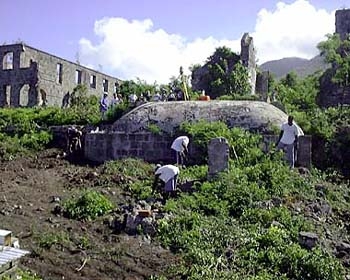On this site:
- Homepage:
- The Mountravers Plantation Community, 1734 to 1834
The enslaved people
The employed men - Archival research
- Fieldwork
- Other work on Nevis:
Alexander Hamilton and 'Hamilton House'
Bath Hotel
British Library Endangered Archives
Bush Hill Estate
Clarke's Estate
Clifton Estate
Court House
Dasent's Estate
Early Steam Engines
Eden Browne Estate
Montpelier Estate
Scarborough's Estate
Stoney Grove Estate
Tower Hill Estate
Uprising, 1725: Frank's StoryWreck of HMS Solebay - Developments in Bristol
900 names
Servants in the family - Publications, reports and broadcast media
- Acknowledgments
- Contact details, and links to other sites
Aims of our research The importance of Mountravers
Mountravers Plantation (Pinney's Estate) - Nevis, West Indies
Christine Eickelmann and David Small
Fieldwork
A preliminary trip to Nevis in 1991 revealed the extent of the remaining plantation structures on the old Pinney property. Since then fieldwork
on the estate has been carried out by us during seven visits between 1998 and 2008, and at our suggestion by Channel 4's Time Team in 1998.
For two programmes screened in the spring of 1999 the team searched for the estate's slave village and also for the location of the island's first
capital at Jamestown. In addition, the Time Team archaeologists investigated a prehistoric site at Coconut Walk. See Time Team Series 6,
episodes 12 and 13 on All 4.
Since then follow-up fieldwork has been carried out on the estate by the 'Colonial Landscape' arm of the Nevis Heritage Project (NHP), set up by Dr Elaine Morris of the Department of Archaeology at the University of Southampton (see Nevis Heritage Project Interim Reports 2000, 2001 and 2002). Also, in June and July 2006 a team from the Department of Archaeology and Anthropology at University of Bristol, led by David Small, conducted an independent field evaluation of seven sites on the wider Pinney's Estate which had not thus far been evaluated (see C Newland, D Small, A Witkin Pinney's Estate - An Archaeological Evaluation of Seven Selected Sites, 2006). This was an independent evaluation but supported financially by Newfound Developers Group.
 Members of Time Team excavating at the Great House site
Members of Time Team excavating at the Great House site(C Eickelmann, 1998)
Developments
- Some of the standing structures in the area of the Great House were identified and provisionally dated, including two houses, the counting house, a kitchen, a cistern and a 'slave dungeon', or hurricane shelter (Time Team, David Small, 1998).
- The area of the slave village was provisionally located in 1998 (Stewart Ainsworth of Time Team, Charlie Woodley and David Rollinson of Nevis, and David Small).
- In 2000, a survey of a small area of the slave village, together with a surface pickup, was carried out (NHP, 2000). This was followed by excavation of several standing structures and partial excavation of a grave in 2001 (NHP, 2001). Further excavation at the Great House site developed work begun by Time Team (NHP, 2001, 2002). Also, the site of the upper plantation works at Woodland was located and recorded (NHP, 2001) and visited in 2002 (Small and Eickelmann).
- Fieldwalking extended the area of search within the slave village, possible pen structures were identified and recorded near the site of the main plantation works, and some of the plantation roads were identified (Small and Eickelmann, 2000, 2001 and 2002).
- The recording of the main plantation works at Pinney's Yard/Sharloes, begun in 2001, was continued in 2002 (Small and Rollinson) and separately by the Southampton team in 2002. Identified were remains of the substantial works built by Peter Thomas Huggins which show signs of twentieth-century alteration. Also recorded were earlier structures likely to have been built in the Pinney era.
- In 2004 further recording of the Great House site was undertaken and fieldwalking was again used to extend the area of search within the slave village site (Small and Eickelmann).
- In 2006 the Bristol University field evaluation team extended the area of search for remains of the slave village into two new areas, attempted to locate the remains of the pre-emancipation Scarborough Chapel and recorded the remains of a small, late seventeenth-century boiling bench and associated sugar works. In addition, trial excavations on two house platforms in the last remaining corner of Nugent's Village indicated that the village dates to the post-emancipation era. Also recorded were structures on the south side of the main works at Pinney's Yard (Newland, Small and Witkin, 2006).
- During limited work in 2008 GPS was used on boundary features of three sites in particular - Woodland works, the slave village and Scarborough's house and works - to assist parties on Nevis with accurately locating the sites. In the course of this another possible grave was identified in the vicinity of the slave village (Small and Eickelmann).
- From 2006 to 2009 David Small assisted the Nevis Department of Physical Planning, the Nevis Historical and Conservation Society and the property developers in drawing up guidelines for the conservation and preservation of historic sites on the estate. Recommendations were made in the Environmental Impact Report; see Hyder Consulting Report No NEO 2657/2, March 2008.
- In May 2013 various consultants produced an ‘Addendum’ to the 2008 EIA (a revised EIA) for another potential developer (Daren Burney of the Burney Group). For both reports see Publications, reports and broadcast media.